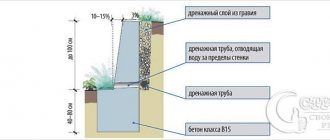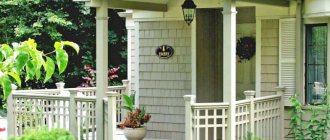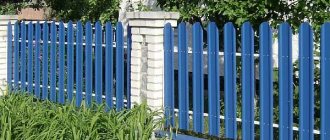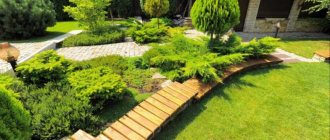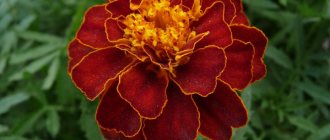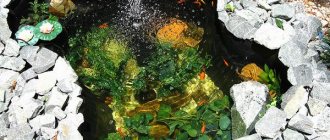A front garden created with your own hands is the calling card of a private home, the first thing that attracts attention. It should be unique and attract attention. To achieve such a result you will have to spend a lot of effort and learn a lot. So, how to decorate the front garden in front of the house? Let's consider the main points and recommendations of design professionals.
The front garden is the first thing people pay attention to
The garden should be beautiful and attract attention
To decorate your front garden beautifully, use the recommendations of experts
Which style to choose
The Russian style is characterized by a riot of colors, the presence of Slavic sculptures and painted household utensils (jugs, pots, etc.) in the compositions. A boletus mushroom, a basket with berries and animal figurines will fit perfectly into this style.
The European style is characterized by minimalism, trimmed lawns, perfectly smooth paths, and the absence of funny, cute figures and sculptures.
Asian, done in restrained colors, not bright colors, definitely a stone fence and compositions of several tiers.
The romantic style is traditionally presented in the form of a bench, always forged, climbing plants, a flower garden with a selection of white and mixed flowering plants, and a low fence.
Japanese style. Slides made of stone, planted with coniferous trees with elements of dwarf plants.
Designing a front garden in front of a house with your own hands is a creative process and gives you the opportunity to choose any style, embody a bold idea, but it is desirable that in the finished version you get exactly what you wanted - a beautiful, stylish, complete composition. To get what you want, you need to understand the nuances of the process in more detail.
Stages of planning a front garden near a house
Work on decorating a front garden should begin, first of all, with planning. In this case, it is necessary to take into account the following factors:
- Land area. This criterion is of fundamental importance, since it will simply be impossible to create certain compositions in a small area, and some flower bed models may get lost in a spacious area.
- Time. It should be taken into account how much time the owner will spend not only on creating the front garden, but also on its constant maintenance. The landscaped area requires constant attention. The range of plants depends on this.
- Material resources. Seeds and seedlings of beautiful elite flowers, bushes and trees are not cheap. You need to think about where it is more profitable to buy them. This also applies to materials for a high-quality fence or paths.
- Seasonality. It’s one thing if the front garden is located near the house where they permanently live, another thing if it’s a summer house or dacha where they come periodically.
- Location. The cardinal directions play an important role, since a small front garden on the north side will be excessively darkened, and on the south, on the contrary, it will be exposed to the scorching sun. This affects the range of plants.
When planning a front garden, you should take into account the location of the house and car parking, and the landscaping of the space as a whole.
All of these factors must be taken into account before deciding how to design the front garden in front of the house. You should also not forget about the style and general idea.
Execution Sequence
Make a detailed plan of the site, plan the location of all zones and correctly form groups of plants, so that later tall plants do not end up in a group with short ones, otherwise in the future you will have to decide whether to cut down the tree or replant the flowers.
Having decided on the type of front garden and fence, you can begin choosing the interior design of the site.
Divide the territory into zones and thoughtfully fill each of them with elements, taking into account their compatibility in shape, color and style.
Having decided on all the components, you can proceed to the financial side of the issue. Having made the first “rough” calculations, we can make a conclusion whether it is actually possible to implement it, or whether the costs exceed the possibilities. If difficulties arise, you can simply review the materials and their cost and find an alternative.
Advantages and disadvantages
Sometimes owners of private houses do not understand why front gardens are needed and what their benefits are. Let's look at their main advantages.
- A decorative garden in front of the house will allow you to hide the building from random passers-by.
- You can install a mailbox in the flowerbed area.
- In the front garden you can find a place for a children's playground. Sometimes a swing and, for example, a playhouse or a sandbox are enough (you will have to think about its installation so that the sand does not crumble).
- Among the plantings you can successfully camouflage garbage containers.
- You can also plant fruit and berry plants in the front garden.
- The ability to hide certain imperfections on the facade of the house and emphasize the chosen style.
There is only one drawback to creating a front garden: the need to constantly care for the plants and keep the garden in order.
With the help of a front garden you can hide the shortcomings of the site
Wicker flowers will perfectly complement the overall picture of the garden
See alsoRecommendations for creating a design project for a vegetable garden with beds
Types of front gardens
Structurally, they are distinguished:
- open front garden, the peculiarity of this type is that there is no fence separating the area from the road. It is rational to make such a choice if the site is far from the road and there are no permanent sources of pollution. The site is divided into zones and may contain trees, bushes, and flower arrangements;
- partially covered, here the front garden area is fenced with low bushes. This type is suitable for use both far from the road and in places with little dust. An additional advantage of fencing with shrubs is the ability to give them fancy shapes, which will add a “zest” to the front garden;
- closed type, the territory is completely fenced along the entire outer perimeter with tall trees or bushes. The main functional responsibilities of such a design solution are to retain dust and exhaust gases;
- formal appearance, fully corresponds to its name, it is so small in size that it can only conditionally be classified as a type of front garden. This type is used in densely populated areas; plants are planted in containers or wooden boxes and installed near the entrance.
Features of choosing fences for the front garden
A fence for a front garden is called a “palisade”. In addition, there are several types of fences for the palisade:
- A blind fence is a fence with a height of 4 meters. A blind fence is made of brick, wood, concrete, corrugated board and metal.
- Open fence - if you have such a fence, you must always maintain the front garden in good condition, due to the fact that it is constantly in sight.
The material for such a fence can be metal, wood, chain-link mesh, welded fences, forged fencing, and so on.
Functional differences
The area in front of the house can perform: decorative, environmental and productive (economic) functions.
Decorative model. Direct purpose: decoration of the site. For these purposes, various flowers from tall to dwarf sizes, fancy shrubs and climbing plants can be used.
The ecological function is largely performed by trees that are capable of removing dust and harmful gases from the air as much as possible. Poplar and eucalyptus cope well with this function.
Productive, economic function. Makes it possible to receive visual pleasure and harvest from fruit-bearing trees and shrubs.
Made of wood
Wood is one of the most popular materials used for the construction of structures separating the area between the house and the road.
The advantages of such wooden fences include:
- large selection of designs and sizes (from low to very low);
- ease of installation;
- simplicity of design;
- budget price.
Important! Wooden fences need to be treated with protective compounds, otherwise they will quickly wear out under the influence of natural factors and become unusable.
To paint wooden fences located in the front garden area, you can use acrylic, oil and enamel paints. Antiseptic compounds significantly extend the service life of such fences.
Wooden fences are divided into several categories:
- with openings between the main parts;
- solid;
- with vertically located boards;
- with horizontal boards;
- with diagonally placed boards.
Types of fence
A fence will help give a finished look to a designer’s masterpiece; it can decorate, as an artist’s finishing touch, and at the same time fulfill its direct function: protect from dust, exhaust gases and separate the house from the road.
A fence for a front garden with your own hands is a calling card not only of the house, but also of the master who put the work into his creation. The process is exciting and exciting, especially since the abundance of options makes it possible to make a fence:
- wood;
- hedge (trees, shrubs);
- metal;
- stone;
- wicker;
- from decorative mesh;
- combined.
Wood products, due to their environmental friendliness and naturalness, have always been a priority. DIY wooden front gardens fit most naturally into the surrounding landscape.
Plant selection
As you can see in the photo of the front garden in front of the house, you should choose the “filling” for it responsibly, focusing on the style of the site as a whole.
Of course, there are several other factors to consider:
- personal taste;
- features of vegetation care;
- climatic preferences of plants.
Since the front garden is usually located on the sunny side, we advise you to take a closer look at daisies, phlox, asters, peonies and other light-loving flowers.
- Boxwood: planting, care, growing in open ground, propagation. Full description of the plant from A to Z. More than 100 photos of evergreen shrubs
- Living fence - the best ideas on what to make a hedge from at your summer cottage. Many photos of ready-made options with exclusive designs + instructions
- Trimming bushes - the basics of choosing the right plants and forming the right shapes, selecting tools (photo + video)
It is important to take into account the characteristics of flowering. Different species bloom not only in different months, but also at different times of day. This principle underlies the design of flower clocks.
The harmony of the landscape is achieved by choosing crops of different heights.
If you want your front garden to delight you with colors throughout the season, stop at phlox, petunias, cosmos, roses, hydrangeas, crocuses, tulips, daffodils, hyacinths, and irises.
Perennials must be planted keeping a distance of 1 m. This will give them room to grow. It is appropriate to plant the gaps between them with annual plants. However, in this case, their compatibility must be taken into account.
Flowers in the front garden should be selected so that the flowering of some is followed by the blooming of others. Flower beds and flower beds can be supplemented with flowerpots and flowerpots. It is appropriate to place garden figurines near flower arrangements, equip stone slides, and arrange wooden decor.
The color of the flower bed must be contrasting. The ideal combination is red and purple. This combination of flowers is produced by hollyhocks, roses, peonies, dahlias, and asters.
As for fruit trees, they often have a spreading crown, making them more suitable for planting in the backyard. For a front garden, it is better to choose standard varieties with a neat crown and an even stem.
Barberry or rose hips are suitable for creating a hedge. They will delight you not only with fragrant flowers, but also with bright fruits.
Conifers will be an excellent option if you prefer the correct geometry in landscape design. Experts advise choosing species that can withstand decorative pruning well.
Low-growing varieties of yew, thuja, juniper, spruce - the choice is quite wide. You should avoid tall plants - they block your view.
It is advisable to decorate wrought-iron front gardens with climbing varieties of greenery. You can grow wisteria or wild grapes along the trellises. Or you can stay with the same roses and clematis.
How to decorate the front garden
Having decided on the style, functionality and fencing of the front garden, the question arises: how to decorate the front garden with your own hands, what to choose? Of course, you need to proceed from the chosen style.
Flowers. It is important to choose according to the color scheme, and also take into account the fact of combining the plants with each other and the growing seasons.
Shrubs and trees. Low and tall plants should be distributed taking into account sunlight, eliminating the fact of darkening, this will promote good growth.
Stones and sculptures also need to be chosen in accordance with the chosen style, then everything will look organic.
With decorative sculptures
It would be ideal if, upon entering the front garden, you and your guests will be greeted by well-chosen objects that organically fit into the landscape, and not by bright, poorly executed figures from the nearest store.
The variety of garden sculptures is so great that you can choose any suitable product from them. Antique figurines made of artificial stone or concrete, stone spheres, crafts made of wood and metal, and mini-gardens will never become outdated.
Some objects can be made with your own hands, and if desired, you can turn an ugly building (for example, a well) into a lighthouse or a mill, thereby camouflaging it.
What flowers to plant
The main selection criterion is the desire to plant annually, or not change the composition for several years. Annual plants provide the opportunity to plant new types of plants every year.
Accordingly, perennials will grow on the site for many years. Design solution: combining annual and perennial plants will be the most interesting and rational option.
Front garden in front of the house: types and style
When creating an ideal front garden, it is important to know its main types, take into account its purpose and role. There are two main types of home garden:
- open;
- closed.
An open front garden is an area consisting mainly of lawn and flower beds, separated by paved paths. Such an area contains a minimum of plants from the tree and shrub group. Openness creates a good overview of the house and the surrounding area. The name of a closed front garden is due to the presence of a fence, which can be in the form of a hedge or in the form of small architectural forms. The choice of the type of site depends on the preferences of the owner: closed is recommended for those who love peace, solitude and silence, open - for those who like to be in front of everyone.
Open front garden - does not contain a large number of trees and shrubs, and visibility from all sides is very good, which allows you to view the house and its surrounding area
Each owner of a local area, when creating a front garden, must have his own idea and concept, based on which a specific style solution is formed. Here you can give full rein to your imagination, plant your favorite plants, without forgetting about a sense of proportion. You can find many design options on the Internet, using photos of the front gardens near the house as a sample.
Helpful advice ! If you plan to set up a front garden near a residential building, you should consider planting evergreens to decorate the area in winter. Particularly pleasing to the eye are small thujas, fir trees, as well as euonymus, honeysuckle or boxwood.
Style and design of the landscape in front of the house
Depending on the type chosen, the style and design of the front garden is selected. Some prefer classics, others prefer modern or country. More details about each below.
A front garden in a modern style is often decorated with natural stones, as well as paths made from screenings
- Country, or rustic style, is very common due to its simplicity and originality. A popular design method is to plant perennial plants surrounded by a low wooden or wicker fence.
- The Asian front garden is usually decorated with mixborders, which are planted with perennial flowers with discreet colors. Small coniferous plants are perfect. The presence of tiers is ensured by the delimitation of exclusively natural stones: this style does not allow other materials.
- Mediterranean design includes the presence of mobile objects. Plants are planted in specially designed tubs and containers. In such a front garden they usually create a relaxation area with sun loungers and tables made of natural wood. Crafts, figurines, and lanterns serve as decoration.
- In the romantic style, the main emphasis is on vegetation, embodying beauty and sophistication. Complemented by forged fences and arches with climbing plants.
- Contemporary style includes original and exotic plants that can be shaped. Particularly popular are trimmed boxwoods or larch. The composition is complemented by paths made from screenings and natural stones.
- Japanese style involves a combination of natural stones with coniferous plants. Flower beds are planted with perennial crops, such as daylilies, irises or cereals.
There are many ideas for decorating a front garden in various style solutions that you can come up with and implement yourself.
It is quite difficult to maintain a specific style on your own, without the involvement of designers. Among other things, this requires certain financial costs. Therefore, quite often owners prefer a combination of several (usually two) styles.
Path to the house
The main functional responsibilities are to ensure passage through the front garden, so you need to take into account the climate zone and select the material in accordance with the weather conditions.
The path in the front garden is a separate element of aesthetic addition, so it can be made of decorative stone, tiles, sprinkled with crushed stone, gravel and combined with various decorative accessories.
Creativity, in any of its manifestations, has a beneficial effect on the human body, promotes good mood and increased vitality. Desire and a little patience are all that a creative person needs and the front garden of your dreams is already a reality.
Advantages of wooden fencing
It is no secret that wood, which has excellent qualities, has been used in construction for a long time. With the advent of plastic and other analogues in the world of building materials, interest in wood has not disappeared, since the naturalness of raw materials is always valued above any extended service life.
For a front garden, a low fence is usually chosen, the main purpose of which is to delimit the territory and protect plants from the possible negative impact of environmental factors.
Construction of a small log fence
The main purpose of such a fence remains to give aesthetic completeness to the front garden, as well as to create a harmonious image of the site. Basically, wooden front gardens are made according to the picket fence principle, when boards of the same parameters are packed perpendicularly onto two parallel guides. This is the most convenient option for working with wood, since a solid wooden fence will not last long and will not have the qualities that a picket fence has.
In addition to the picket fence, decorative wood carving is often used, when individual elements of the fence are attached in a graphic sequence, the final result is a beautiful mosaic decorative fence.
To arrange the front garden, you can also use any lumber that can be attached individually, directly into the ground.
Design of a picket fence for a front garden
No less beautiful and in demand is a wicker fence made of vines, when dried tree twigs are intertwined through support posts, forming a fence.
Return to contents
Photo ideas for beautiful homemade front gardens
With a rosary
Even the most modest house will look luxurious surrounded by colorful roses. The best place for planting them is the sunny side with low groundwater. The soil should be light, fertile, with good drainage.
If you set aside an entire front garden for rose bushes, your area will stand out with its beauty, royal elegance and richness of colors.
The front garden is a grand place, worthy of better design and a responsible approach to the choice of plants and sculptures.
Basic Rules
A beautiful front garden design should take into account all its components.
The location and composition of the selected plants harmoniously complement the existing plantings. The fence and decorative elements are in the same color and stylistic range with the rest of the decorations on the site.
At the same time, we should not forget that most often the front garden is the face of the house and land plot, and the first impression of the territory depends on it.
Combination of various materials
Another interesting proposal for arranging a fence around the front garden is to combine fences from different materials, for example, combining a wrought-iron fence with a concrete foundation. Brick with corrugated board or wood will also look beautiful. The “high-tech” style has become very popular, when stonework is complemented by plastic. In every job, the main thing is patience and work. The imagination and capabilities of the home owners will help you make the desired fence for the front garden.

